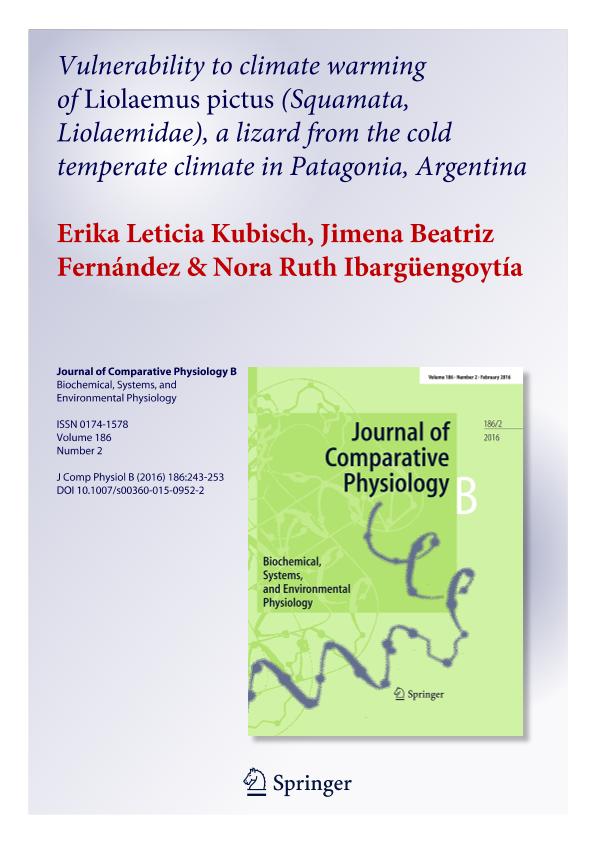Mostrar el registro sencillo del ítem
dc.contributor.author
Kubisch, Erika Leticia

dc.contributor.author
Fernandez, Jimena Beatriz

dc.contributor.author
Ibarguengoytía, Nora

dc.date.available
2018-09-24T20:21:29Z
dc.date.issued
2016-02
dc.identifier.citation
Kubisch, Erika Leticia; Fernandez, Jimena Beatriz; Ibarguengoytía, Nora; Vulnerability to climate warming of Liolaemus pictus (Squamata, Liolaemidae), a lizard from the cold temperate climate in Patagonia, Argentina; Springer Heidelberg; Journal of Comparative Physiology B: Biochemical, Systems and Environmental Physiology; 186; 2; 2-2016; 243-253
dc.identifier.issn
0174-1578
dc.identifier.uri
http://hdl.handle.net/11336/60822
dc.description.abstract
The vulnerability of populations and species to global warming depends not only on the environmental temperatures, but also on the behavioral and physiological abilities to respond to these changes. In this sense, the knowledge of an organism’s sensitivity to temperature variation is essential to predict potential responses to climate warming. In particular, it is interesting to know how close species are to their thermal limits in nature and whether physiological plasticity is a potential short-term response to warming climates. We exposed Liolaemus pictus lizards, from northern Patagonia, to either 21 or 31 °C for 30 days to compare the effects of these treatments on thermal sensitivity in 1 and 0.2 m runs, preferred body temperature (Tpref), panting threshold (Tpant), and critical minimum temperature (CTMin). Furthermore, we measured the availability of thermal microenvironments (operative temperatures; Te) to measure how close L. pictus is, in nature, to its optimal locomotor performance (To) and thermal limits. L. pictus showed limited physiological plasticity, since the acclimation temperature (21 and 31 °C) did not affect the locomotor performance nor did it affect Tpref, the Tpant, or the CTMin. The mean Te was close to To and was 17 °C lower than the CTMax. The results suggest that L. pictus, in a climate change scenario, could be vulnerable to the predicted temperature increment, as this species currently lives in an environment with temperatures close to their highest locomotor temperature threshold, and because they showed limited acclimation capacity to adjust to new thermal conditions by physiological plasticity. Nevertheless, L. pictus can run at 80 % or faster of its maximum speed across a wide range of temperatures near To, an ability which would attenuate the impact of global warming.
dc.format
application/pdf
dc.language.iso
eng
dc.publisher
Springer Heidelberg

dc.rights
info:eu-repo/semantics/openAccess
dc.rights.uri
https://creativecommons.org/licenses/by-nc-sa/2.5/ar/
dc.subject
Acclimation
dc.subject
Climate Change
dc.subject
Critical Temperature
dc.subject
Liolaemidae
dc.subject
Lizard
dc.subject
Locomotor Performance
dc.subject
Panting Threshold
dc.subject
Patagonia
dc.subject
Phenotypic Plasticity
dc.subject
Preferred Temperature
dc.subject.classification
Otras Ciencias Biológicas

dc.subject.classification
Ciencias Biológicas

dc.subject.classification
CIENCIAS NATURALES Y EXACTAS

dc.title
Vulnerability to climate warming of Liolaemus pictus (Squamata, Liolaemidae), a lizard from the cold temperate climate in Patagonia, Argentina
dc.type
info:eu-repo/semantics/article
dc.type
info:ar-repo/semantics/artículo
dc.type
info:eu-repo/semantics/publishedVersion
dc.date.updated
2018-09-24T14:06:14Z
dc.journal.volume
186
dc.journal.number
2
dc.journal.pagination
243-253
dc.journal.pais
Alemania

dc.journal.ciudad
Heidelberg
dc.description.fil
Fil: Kubisch, Erika Leticia. Consejo Nacional de Investigaciones Científicas y Técnicas. Centro Científico Tecnológico Conicet - Patagonia Norte. Instituto de Investigaciones en Biodiversidad y Medioambiente. Universidad Nacional del Comahue. Centro Regional Universidad Bariloche. Instituto de Investigaciones en Biodiversidad y Medioambiente; Argentina
dc.description.fil
Fil: Fernandez, Jimena Beatriz. Consejo Nacional de Investigaciones Científicas y Técnicas. Centro Científico Tecnológico Conicet - Patagonia Norte. Instituto de Investigaciones en Biodiversidad y Medioambiente. Universidad Nacional del Comahue. Centro Regional Universidad Bariloche. Instituto de Investigaciones en Biodiversidad y Medioambiente; Argentina
dc.description.fil
Fil: Ibarguengoytía, Nora. Consejo Nacional de Investigaciones Científicas y Técnicas. Centro Científico Tecnológico Conicet - Patagonia Norte. Instituto de Investigaciones en Biodiversidad y Medioambiente. Universidad Nacional del Comahue. Centro Regional Universidad Bariloche. Instituto de Investigaciones en Biodiversidad y Medioambiente; Argentina
dc.journal.title
Journal of Comparative Physiology B: Biochemical, Systems and Environmental Physiology

dc.relation.alternativeid
info:eu-repo/semantics/altIdentifier/doi/https://dx.doi.org/10.1007/s00360-015-0952-2
dc.relation.alternativeid
info:eu-repo/semantics/altIdentifier/url/https://link.springer.com/article/10.1007/s00360-015-0952-2
Archivos asociados
